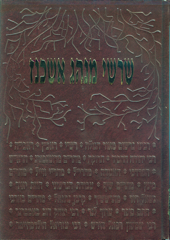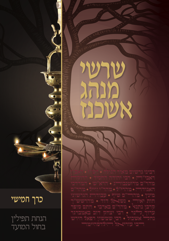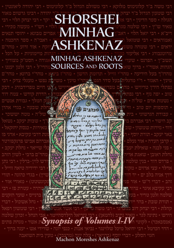Shorshei Minhag Ashkenaz
4 Tishrei 5755
גדולי הדורות על משמר מנהג אשכנז
Leading Rabbis throughout the Generations on the Guarding of Minhag Ashkenaz (Hebrew)
Introduction to the series Shorshei Minhag Ashkenaz
by Rav Binyomin Shlomo Hamburger
Bnei Brak, 5754
127 pages
4 Tishrei 5765
שרשי מנהג אשכנז
Shorshei Minhag Ashkenaz (Hebrew)
by Rav Binyomin Shlomo Hamburger
Bnei Brak
5 vols.
Volume 5 is currently available. Volume 6 and a second edition of volumes 1 and 4 are currently in preparation, and reprinting of the entire series is expected in the near future.
Vol. 1 (5755), 481 pages
Vol. 2 (5760), 619 pages: Table of Contents | Sample Pages
Vol. 3 (5762), 550 pages: Table of Contents | Sample Pages
Vol. 4 (5764), 595 pages: Table of Contents | Sample Pages
Vol. 5 (5778), 917 pages: Table of Contents | Sample Pages
Foremost in the effort of Machon Moreshes Ashkenaz during the last thirty years to research, archive, preserve and disseminate the over-one-thousand-year-old, magnificent heritage of Ashkenaz has been the publication of this monumental series, which researches the evolution of German-Jewish customs and traditions, their development, origins and views surrounding them, in a detailed and clear format.
These books have become an invaluable asset for anyone with an interest in Jewish customs in general and German-Jewish customs in particular. The series is intended to expand to tens of volumes, and currently includes a wide range of topics such as minhagim of tefillah and shul, Shabbos and Yom Tov, marriage customs, yoledes and bris milah, as well as a variety of other minhagim.
4 Tishrei 5756
שרשי מנהג אשכנז: כרך ראשון
Shorshei Minhag Ashkenaz (Hebrew): Vol. 1
Bnei Brak, 5755
481 pages
4 Tishrei 5761
שרשי מנהג אשכנז: כרך שני
Shorshei Minhag Ashkenaz (Hebrew): Vol. 2
Bnei Brak, 5760
619 pages
4 Tishrei 5763
שרשי מנהג אשכנז: כרך שלישי
Shorshei Minhag Ashkenaz (Hebrew): Vol. 3
Bnei Brak, 5762
550 pages
4 Tishrei 5765
שרשי מנהג אשכנז: כרך רביעי
Shorshei Minhag Ashkenaz (Hebrew): Vol. 4
Bnei Brak, 5764
595 pages
28 Adar 5778
שרשי מנהג אשכנז: כרך חמישי: הנחת תפילין בחול המועד
Shorshei Minhag Ashkenaz (Hebrew): Vol. 5: Wearing Tefillin on Chol haMoed
by Rav Binyomin Shlomo Hamburger
Bnei Brak, 5778
917 pages
Distributed by Yefe Nof-Feldheim. Available in fine Jewish bookstores.
Table of Contents | Sample Pages
מחלוקת עתיקת יומין, החריפה, הקיצונית והממושכת ביותר בתולדות ישראל, סובבת את השאלה אם חובה להניח תפילין בימי חול המועד, או לפחות אם מותר להניח בהם תפילין, או שמא אסור חול המועד בהנחת תפילין ויש בו עוון מיתה. על עוצמתה של מחלוקת כבירה זו עמדו כמה חכמים, שמבחר מדבריהם יובא פה:
11 Cheshvan 5771
Shorshei Minhag Ashkenaz (English)
Minhag Ashkenaz: Sources and Roots
Synopsis of Volumes I–IV
by Rav Binyomin Shlomo Hamburger
Translated by David Silverberg
Bnei Brak, 5771
223 pages
Distributed by Yefe Nof-Feldheim. Available in fine Jewish bookstores.
Table of Contents | Sample Pages
Foremost in the effort of Machon Moreshes Ashkenaz during the last thirty years to research, archive, preserve and disseminate the over-one-thousand-year-old, magnificent heritage of Ashkenaz has been the publication of the monumental series Shorshei Minhag Ashkenaz, which researches the evolution of German-Jewish customs and traditions, their development, origins and views surrounding them, in a detailed and clear format.
These books have become an invaluable asset for anyone with an interest in Jewish customs in general and German-Jewish customs in particular. Intended to expand to tens of volumes, the series is currently comprised of four, which include a wide range of topics such as minhagim of tefillah and shul, Shabbos and Yom Tov, marriage customs, yoledes and bris milah, as well as a variety of other minhagim. Those who do not have time to read every chapter in its entirety will nevertheless gain satisfaction from the synopses found at the end of each one.
Despite the great demand for an English translation, this work is thus far available only in Hebrew. However, the synopses following each chapter in the first four volumes have been translated and collected in one volume, so that English readers will be able to find the salient points for their research.



